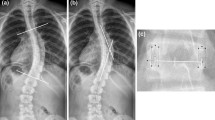Abstract
For several years, digitized small radiographs are used to measure Cobb angle in idiopathic scoliosis. The interobserver and intraobserver Cobb angle measurement variability associated with small radiographs were compared with measurement variability associated with the long-cassette radiographs. Twenty adolescent patients with a double major idiopathic scoliosis had erect full-spine p-A radiographs and Cobb angle measurements performed by eight different observers on a 30 × 90 cm plain-film radiograph and a digitized 14 × 42 cm image. Inter-observer and intra-observer reliability using each techniques were assessed using a paired t-test, Spearman rank correlation study and intraclass correlation coefficients. The angle variability between small film and plain-film measurements was assessed using the same methods. Intra-observer and inter-observer study showed good reliability using both techniques. The comparison between small films and plain-films measurements showed very good agreement with an intraclass correlation coefficient of 95% and confidence interval between 0.962 and 0.972. In our study, Cobb angle determination was not found to vary significantly with film size. The small film image used for full-spine radiographs in our institution allows manual Cobb angle measurements to be performed. A study is currently conducted in our institution to determine if a computer-assisted measurement method significantly improves Cobb angle measurements reliability in routine practice compared with manual measurements of Cobb angles on small films.




Similar content being viewed by others

References
Behensky H, Giesinger K, Ogon M, Krismer M, Hannes B, Karlmeinrad G et al (2002) Multisurgeon assessment of coronal pattern classification systems for adolescent idiopathic scoliosis: reliability and error analysis. Spine 27:762–767
Bland JM, Altman DG (1990) A note on the use of the intraclass correlation coefficient in the evaluation of agreement between two methods of measurement. Comput Biol Med 20:337–340
Carman DL, Browne RH, Birch JG (1990) Measurement of scoliosis and kyphosis radiographs. Intraobserver and interobserver variation. J Bone Joint Surg Am 72:328–333
Cheung J, Wever DJ, Veldhuizen AG, Klein JP, Verdonck B, Nijlunsing R et al (2002) The reliability of quantitative analysis on digital images of the scoliotic spine. Eur Spine J 11:535–542
Chockalingam N, Dangerfield PH, Giakas G, Cochrane T, Dorgan JC (2002) Computer-assisted Cobb measurement of scoliosis. Eur Spine J 11:353–357
Dang NR, Moreau MJ, Hill DL, Mahood JK, Raso J (2005) Intra-observer reproducibility and inter-observer reliability of the radiographic parameters in the Spinal Deformity Study Group’s AIS Radiographic Measurement Manual. Spine 30:1064–1069
Diab KM, Sevastik JA, Hedlund R, Suliman IA (1995) Accuracy and applicability of measurement of the scoliotic angle at the frontal plane by Cobb’s method, by Ferguson’s method and by a new method. Eur Spine J 4:291–295
Dutton KE, Jones TJ, Slinger BS, Scull ER, O’Connor J (1989) Reliability of the Cobb angle index derived by traditional and computer assisted methods. Australas Phys Eng Sci Med 12:16–23
Goldberg MS, Poitras B, Mayo NE, Labelle H, Bourassa R, Cloutier R (1988) Observer variation in assessing spinal curvature and skeletal development in adolescent idiopathic scoliosis. Spine 13:1371–1377
Kuklo TR, Potter BK, O’Brien MF, Schroeder TM, Lenke LG, Polly DW Jr (2005) Reliability analysis for digital adolescent idiopathic scoliosis measurements. J Spinal Disord Tech 18:152–159
Kuklo TR, Potter BK, Polly DW Jr, O’Brien MF, Schroeder TM, Lenke LG (2005) Reliability analysis for manual adolescent idiopathic scoliosis measurements. Spine 30:444–454
Kundel HL, Polansky M, Dalinka MK, Choplin RH, Gefter WB, Kneelend JB et al (2001) Reliability of soft-copy versus hard-copy interpretation of emergency department radiographs: a prototype study. AJR Am J Roentgenol 177:525–528
Lin LI (1989) A concordance correlation coefficient to evaluate reproducibility. Biometrics 45:255–268
Lyon R, Liu XC, Thometz JG, Nelson ER, Logan B (2004) Reproducibility of spinal back-contour measurements taken with raster stereography in adolescent idiopathic scoliosis. Am J Orthop 33:67–70
Morrissy RT, Goldsmith GS, Hall EC, Kehl D, Cowie GH (1990) Measurement of the Cobb angle on radiographs of patients who have scoliosis. Evaluation of intrinsic error. J Bone Joint Surg Am 72:320–327
Oda M, Rauh S, Gregory PB, Silverman FN, Bleck EE (1982) The significance of roentgenographic measurement in scoliosis. J Pediatr Orthop 2:378–382
Pruijs JE, Stengs C, Keessen W (1995) Parameter variation in stable scoliosis. Eur Spine J 4:176–179
Shea KG, Stevens PM, Nelson M, Smith JT, Masters KS, Yandow S (1998) A comparison of manual versus computer-assisted radiographic measurement. Intraobserver measurement variability for Cobb angles. Spine 23:551–555
Stokes IA, Aronsson DD (2006) Computer-assisted algorithms improve reliability of King classification and Cobb angle measurement of scoliosis. Spine 31:665–670
Ylikoski M, Tallroth K (1990) Measurement variations in scoliotic angle, vertebral rotation, vertebral body height, and intervertebral disc space height. J Spinal Disord 3:387–391
Acknowledgments
The authors gratefully acknowledge the assistance provided by Dr Carl Stanitski in the preparation of this manuscript.
Author information
Authors and Affiliations
Corresponding author
Rights and permissions
About this article
Cite this article
De Carvalho, A., Vialle, R., Thomsen, L. et al. Reliability analysis for manual measurement of coronal plane deformity in adolescent scoliosis. Are 30 × 90 cm plain films better than digitized small films?. Eur Spine J 16, 1615–1620 (2007). https://doi.org/10.1007/s00586-007-0437-4
Received:
Revised:
Accepted:
Published:
Issue Date:
DOI: https://doi.org/10.1007/s00586-007-0437-4



